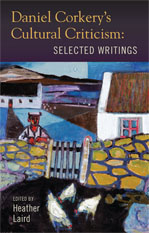Heather Laird (ed.): Daniel Corkery’s Cultural Criticism: Selected Writings, Cork University Press, 2012.
ISBN: 9781859184554
RRP: €39.00
Heather Laird’s splendid book is a smorgasbord of insights into the twists and turns of Irish literature as well as a clear affirmation of the important place Daniel Corkery holds in the history of Gaelic culture.
This St. Patrick’s day, I watched, on the internet, the President of Ireland, Michael D Higgins, hosting a dozen poets and singers in a one-hour television special. He spoke about strengthening Ireland’s awareness of its cultural riches as part of the remedy for the present hard times. I was reinforced in my view that Laird has written a book relevant to our day.
While her title, Daniel Corkery’s Cultural Criticism: Selected Writings, indicates that this is a scholarly work, the book is accessible to the general reader. Laird’s superb introduction along with the essays by Corkery and his critics offer much food for thought on what it is to be Irish.
Laird makes clear how pundits, who suffered from cultural cringe, have tried to play down Corkery’s writings, especially Hidden Ireland (1924) and Synge and Anglo-Irish Literature (1931). In reality, Corkery, whatever his faults, puts his reader in touch with a lost body of Irish literature.
Corkery’s 1924 book was about the way mainstream English-language writing about Irish history had obscured Gaelic culture. Corkery was opposed to books which drew on state papers, emphasised English sources about Ireland and ignored Gaelic poems and songs. Corkery focused on some Irish-language poets of eighteenth-century Munster of whom the most famous was Aogán Ó Rathaille.
I have been putting off writing this review because there are so many things to be said about the book. But I have decided to abandon a comprehensive review in favour of a personal response.
In June 2012, Ballarat Heritage Services published my illustrated book called Hidden Ireland in Victoria. I had collected material for some sixteen years and I had spent three years writing the book before getting clear what title to use. I decided to echo Corkery’s of 1924.
I knew that revisionist writers had dismissed Corkery as a narrow-minded and old-fashioned nationalist. I studied criticisms of Corkery written by Louis Cullen and Breandán Ó Buachalla. I found out, for instance, that not all the poets were as poor as claimed, that the poets differed among themselves and were, at times, more sophisticated politically than Corkery made out. On balance, however, Cullen and Ó Buachalla agreed that the Gaelic poets were important for our understanding of Irish literature.
I concluded that, whatever about the debates, Hidden Ireland has become a suitable, if not standard phrase, for neglected aspects of Irish history and culture, and hence fitted my findings about Gaelic culture in southeast Australia, which have been mostly hidden from mainstream works of history and cultural criticism.
Four months after my book was published, Frances Devlin-Glass sent me Heather Laird’s book for review. I was thrilled to read it. Laird confirmed that Corkery was worth taking seriously, and indeed could be better understood as part of an international anti-colonial stream. Without holding Laird to any view about my book, she strengthened my sense that I had uncovered a Hidden Ireland down under.
Laird’s book has four parts. The first three are selections from Corkery on: the role of Irish language in culture; how Ireland is represented in literature; and the role of the nation state. The fourth part consists of lively contemporary reactions to Corkery from Seán Ó Riordáin, Aodh de Blacam, Dorothy McArdle, Frank O’Connor, Seán Ó Faoláin and others.
One of the surprises is Corkery’s piece on the Anglo-Irish Treaty of 1921 which does not mention Ireland or the treaty. Instead, Corkery produced comments on and selections from Paracelsus, an 1835 poem by Robert Browning about pioneering colonisers who land in the wrong place but try to ignore their mistake.
Dozens of major and minor figures of Irish literature wander into Laird’s pages and she supplies helpful short biographical notes on them and a detailed chronology. I would like to have seen the notes (along with the bibliographical reference for each selection) on the page, not at the back of the book. Perhaps a larger page size with marginal notes might have worked.
My criticisms of her introduction are minor. For instance, I feel that Corkery’s close friends, Tomás MacCurtain and Terence MacSwiney, deserve more than the phrase, ‘died in tragic circumstances during the War of Independence’.
Laird has done us a great service in bringing together the evidence for a reappraisal of Daniel Corkery. If you are at all interested in Irish literature there is something in this book for you. The publishers, Cork University Press, are to be congratulated.
